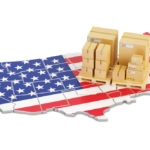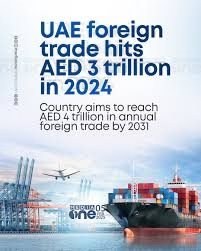The United Arab Emirates (UAE) has achieved a historic milestone in its foreign trade, reaching an all-time high of AED 3 trillion by the end of 2024. This remarkable achievement underscores the UAE’s position as a global trade hub and its ability to adapt to changing economic landscapes. Pakistan, as a key trading partner, has played a significant role in this success. In this article, we’ll explore the factors behind the UAE’s trade growth, Pakistan’s contribution, and the future outlook for bilateral trade relations.
UAE’s Foreign Trade: Key Highlights
1. Record-Breaking Trade Volume
The UAE’s foreign trade surged to AED 3 trillion by the end of 2024, marking a significant increase from previous years. This growth is attributed to:
- Diversification of Trade Partners: Expanding trade relations beyond traditional markets.
- Strategic Location: The UAE’s position as a gateway between East and West.
- Infrastructure Development: World-class ports, airports, and free zones facilitating seamless trade.
2. Top Trading Partners
The UAE’s trade portfolio is diverse, with key partners including:
- China: The largest trading partner, driven by electronics, machinery, and textiles.
- India: A major partner in gems, jewelry, and petroleum products.
- United States: Trade in aerospace, defense, and technology.
- Pakistan: A significant contributor in textiles, agriculture, and labor exports.
3. Sector-Wise Growth
The UAE’s trade growth spans multiple sectors, including:
- Oil and Gas: Despite diversification efforts, hydrocarbons remain a major export.
- Technology and Electronics: Increasing imports and re-exports of high-tech goods.
- Textiles and Apparel: A growing market for clothing and fabrics.
- Food and Agriculture: Rising demand for imported food products.
Pakistan’s Contribution to UAE’s Trade Growth
Pakistan has been a vital trading partner for the UAE, contributing significantly to its foreign trade volume. Here’s how Pakistan has played a role:
1. Textile and Apparel Exports
Pakistan is one of the largest exporters of textiles to the UAE, supplying:
- Garments: Ready-made clothing for men, women, and children.
- Home Textiles: Bed linens, towels, and curtains.
- Fabrics: High-quality cotton and synthetic materials.
2. Agricultural Exports
Pakistan’s agricultural products are in high demand in the UAE, including:
- Rice: Basmati and non-Basmati varieties.
- Fruits and Vegetables: Mangoes, oranges, and potatoes.
- Meat and Dairy: Halal meat and dairy products.
3. Labor Exports
Pakistan is a major source of skilled and unskilled labor for the UAE, contributing to sectors like:
- Construction: Workers for infrastructure projects.
- Healthcare: Nurses and medical staff.
- Services: Professionals in hospitality, retail, and logistics.
4. Bilateral Trade Agreements
The UAE and Pakistan have strengthened their trade relations through:
- Preferential Trade Agreements: Reducing tariffs on key products.
- Investment Partnerships: UAE investments in Pakistan’s energy, infrastructure, and real estate sectors.
- Joint Ventures: Collaborations in agriculture, technology, and manufacturing.
Factors Driving UAE-Pakistan Trade Relations
1. Geographic Proximity
The UAE and Pakistan share close geographic ties, making trade efficient and cost-effective.
2. Cultural and Historical Ties
Strong cultural and historical connections have fostered trust and collaboration between the two nations.
3. Economic Complementarity
The UAE’s demand for Pakistani textiles, agriculture, and labor complements Pakistan’s need for investments and technology from the UAE.
4. Government Initiatives
Both governments have implemented policies to boost trade, including:
- Trade Missions: High-level visits to explore new opportunities.
- Ease of Doing Business: Simplified procedures for exporters and investors.
- Digital Trade Platforms: Enhancing transparency and efficiency.
Future Outlook for UAE-Pakistan Trade
The future of UAE-Pakistan trade looks promising, with several opportunities for growth:
1. Expansion of Non-Oil Trade
Both countries are focusing on diversifying trade beyond oil, with potential in sectors like:
- Technology: Collaborations in IT and software development.
- Renewable Energy: Joint projects in solar and wind energy.
- Tourism: Promoting cultural and religious tourism.
2. Increased Investments
The UAE is expected to increase investments in Pakistan’s infrastructure, energy, and real estate sectors, further strengthening economic ties.
3. Enhanced Connectivity
Improved air and sea connectivity will facilitate faster and more efficient trade between the two nations.
4. Focus on Sustainability
Both countries are likely to explore sustainable trade practices, including eco-friendly packaging and green energy solutions.
Conclusion
The UAE’s foreign trade reaching AED 3 trillion by the end of 2024 is a testament to its resilience, strategic vision, and ability to adapt to global economic trends. Pakistan’s contribution to this milestone highlights the strong bilateral trade relations between the two nations. As both countries continue to explore new opportunities and strengthen their partnership, the future of UAE-Pakistan trade looks brighter than ever. Read more about international trades!






